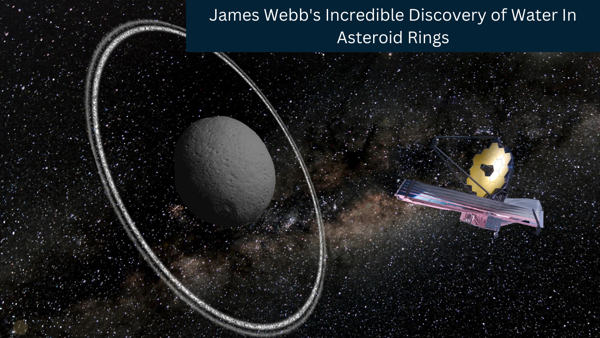
Science & Space
Astronomical Breakthrough: James Webb Discovers Water Ice In Asteroid Rings
The world is amazed by the discoveries James Webb is making since her inception to the space to examine celestial objects with greater accuracy, which its predecessors have missed.
This time, it discovers the bloodline of life, water, in an inhospitable environment where life cannot exist in any way.
The unexpected exceptional discovery is made in the ring of an asteroid, 10199 Chariklo, that is millions of miles away from the earth, orbiting between Saturn and Uranus, grazing the orbit of Uranus.
10199 Chariklo is the largest centaur, that was discovered by James V. Scotti of the Space Watch Program on February 15, 1997. Chariklo was named after the "Nymph Chariklo", the wife of Chiron and daughter of Apollo.
Here, the centaur is an asteroid and comet-like body that can be found between Jupiter and Neptune. It is assumed that it was a Kuiper Belt object orbiting outside of Neptune for 5 billion years before becoming 10199 Chariklo, some celestial event caused a ripple across the solar system, and it became the largest centaur of the solar system after being detached from its core, Kuiper Belt.
And the Spacewatch Project was founded in 1980 by the University of Arizona's Lunar and Planetary Laboratory to study the various populations of small objects in the Solar System, particularly Centaurs, Trojans, main belt asteroids, trans-Neptunium objects, and near-Earth objects, to better understand their dynamical evolution.
About 10199 Chariklo:
Chariklo is the first asteroid ever found with a ring system and it is the fifth ring system celestial body after Saturn, Jupiter, Uranus, and Neptune.
Its diameter is 302 kilometers or 188 miles and its distance from the sun is 18.45 AU or 2,760,080,714.415 kilometers and takes 22,900 days or 62.7 years to complete one orbit around the sun.
At its closest point, Chariklo's orbit is 12.20 AU from Earth's orbit. This means that there is always a large gap between this asteroid and Earth.
According to NASA's JPL, this asteroid will not be going to make contact with our earth in near future.
Ring System of 10199 Chariklo:
However, recent discoveries have astounded scientists about the presence of water ice in its rings.
Prior to James Webb's discovery, there was only speculation about the presence of ice on the asteroid's ring, but James Webb's data dispelled all doubt.
Chariklo's ring system consists of two narrow and dense bands, 6 to 7 kilometers wide separated by 9 kilometers.
As if it was discovered in 1997, but its ring system was not detected due to a lack of observation instruments at the time.
It was discovered on June 3, 2013, and announced on March 26, 2014, by a team of astronomers using ten telescopes in Argentina, Brazil, Chile, and Uruguay during an observation of a stellar occultation.
The two of its rings are named after the two South Amecian Rivers, Oiapoque, a 403 km river in South America between Frech Guiana and Brazil, and Chul, also known as Chuy, which is a short steam on the border of Brazil and Uruguay.
Detection of Water:
10199 Chariklo, is a very small celestial object among other solar system bodies because of that, James Webb used occultation as a powerful method to examine it.
However, the team had no idea when or if a star would fall into Webb's field of view, which is required for an occultation to occur.
As a result, Chariklo became a part of Webb's target of opportunity program: If the asteroid happened to pass in front of a star, the program would allow astronomers to temporarily disrupt the telescope's schedule in order to observe the event.
NASA scientists were extremely fortunate to discover water ice in its ring because the object is too small to detect in the pitch-black sky. Without its transition in front of any star, the detection was impossible.
On October 18, 2022, Chariklo and its two-ring system crossed in front of a star. Astronomers used Webb's near-infrared camera (NIRCam) to monitor the star's brightness for an hour.
As expected, the data showed two dips in the star's brightness: when the asteroid's rings first obscured the star as the eclipse began, and again when the last of its rings completed the occultation.
Conclusive Note:
The presence of ice in a ring of an asteroid helped scientists to understand How the Universe has evolved and constantly evolving around us.
Every input from every tiny object indicates the evolution of the solar system over its lifetime, and the presence of water ice indicates that the asteroid has been associated with bombardment in the past and could be part of any solar system objects or it could have traveled from another solar system, as Oumuamua did in 2017.
Oumuamua left our solar system but it stayed with us like our Kuiper belt objects.
NASA or other space agencies may send a probe to the object to collect more data, similar to how NASA is sending a space probe to a $10 quintillion, 16-Psyche asteroid.

0 Comments